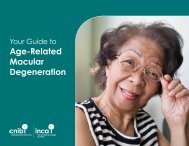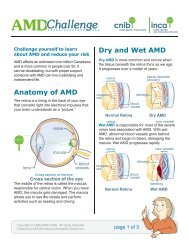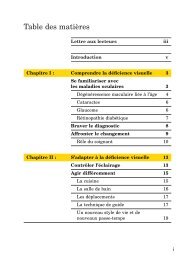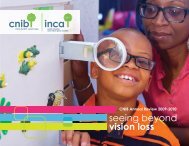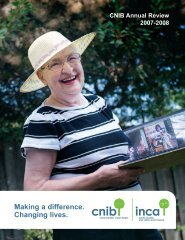Quality of Life in Age-Related Macular Degeneration - CNIB
Quality of Life in Age-Related Macular Degeneration - CNIB
Quality of Life in Age-Related Macular Degeneration - CNIB
Create successful ePaper yourself
Turn your PDF publications into a flip-book with our unique Google optimized e-Paper software.
In a study <strong>of</strong> 50 patients who underwent macular translocation 24 , preand<br />
postoperative visual function (NEIVFQ) and general health status (SF12)<br />
were measured. Overall vision function (NEIVFQ) improved postoperatively<br />
and specifically <strong>in</strong> the subscales measur<strong>in</strong>g general vision, difficulty with<br />
distance vision tasks, difficulty with near vision tasks, dependency, mental<br />
health and social function. Improvement <strong>in</strong> near and distance VA was<br />
associated with greater improvement <strong>in</strong> function (NEIVFQ). Read<strong>in</strong>g speed<br />
improved for 29 patients and this was associated with improvements <strong>in</strong> NEI<br />
VFQ scores. Not surpris<strong>in</strong>gly, there were no changes to SF12 scores. Other<br />
work has reported improvements <strong>in</strong> read<strong>in</strong>g speed follow<strong>in</strong>g macular<br />
translocation 137 138 .<br />
Photodynamic therapy (PDT) for the treatment <strong>of</strong> subfoveal neovascular MD<br />
has undergone extensive trials, but there has been little effort to measure its<br />
effect on QoL or any other patient reported outcomes that may <strong>in</strong>fluence QoL.<br />
In one prospective study <strong>of</strong> PDT 139 , at 12 months followup, 34 <strong>of</strong> 48 treated<br />
patients had lost fewer than 3 l<strong>in</strong>es <strong>of</strong> VA and, on average, the sample lost<br />
fewer than two l<strong>in</strong>es. VF14 items showed either no change or a decrease <strong>in</strong><br />
function, consistent with the VA changes. Participants reported be<strong>in</strong>g less<br />
anxious because <strong>of</strong> MD and that they stayed <strong>in</strong>doors less, but this may have<br />
been due to adjust<strong>in</strong>g to liv<strong>in</strong>g with MD. There was no control group <strong>in</strong> this<br />
study.<br />
An unusual attempt to assess the impact <strong>of</strong> PDT on so called ‘QoL’, was<br />
based on a computergenerated model 56 . Hypothetical patients (characterised<br />
us<strong>in</strong>g data from the TAP study 140 ) were the ‘participants’. Utility values,<br />
36



